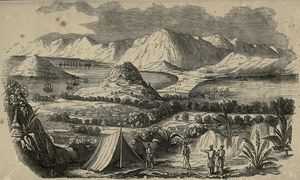Battle of the Barrier
| Battle of the Barrier | |||||||
|---|---|---|---|---|---|---|---|
| Part of First Opium War | |||||||
 View of the barrier between Macau and China (published 1844) | |||||||
| |||||||
| Belligerents | |||||||
| Qing Dynasty | |||||||
| Commanders and leaders | |||||||
| Henry Smith | |||||||
| Strength | |||||||
| 380 troops |
1,500 troops, 9 junks | ||||||
| Casualties and losses | |||||||
| 4 wounded | ~100–180 casualties[nb1][nb2][nb3] | ||||||
The Battle of the Barrier was fought between British and Chinese forces at the boundary between Macau and mainland China on 19 August 1840. The barrier ran across an isthmus separating Macau from mainland China.
Battle
At about noon on 19 August 1840, British corvettes, accompanied by the Louisa cutter and Enterprise steamer, having seamen and marines of the Druid with Bengal volunteers on board, attacked the barrier. The vessels opened fire on a battery about 600 yards (550 m) away which promptly returned fire.[1] A British officer wrote, "The [Chinese] junks, which were aground in the inner harbour, were utterly useless, for none of their guns could be brought to bear, though several of the thirty-two pound shots of the ships found their way over the bank, much to the consternation of the occupants of the junks."[1][2] In less than an hour, the batteries were silenced and the British forces were landed. They consisted of a brigade of 380 men comprising 110 Royal Marines, 90 seamen from the Druid, and 180 troops from the Bengal volunteers.[3]
Gallery
-

An 1841 British sketch of the battle
Notes
- Footnotes
- ^ "The loss of the Chinese cannot be known with any degree of certainty. Those connected with their mandarines state it as only four killed, but other statements at about 50 or 60 killed, and double that number wounded, are probably more correct."[4]
- ^ "The Chinese stated their loss at seven or eight killed: but, without doubt, were either of these numbers multiplied by ten, the amount would be much nearer to the truth".[3][5]
- ^ "The Chinese say they had only 7 or 8 men killed, but others engaged in the action think 100 or more fell."[6]
- Citations
- ↑ 1.0 1.1 Bingham 1843, p. 398
- ↑ Bingham 1843, p. 399
- ↑ 3.0 3.1 Bingham 1843, p. 400
- ↑ Niles' National Register (1841). Volume 59. p. 354.
- ↑ Bingham 1843, p. 401
- ↑ The Chinese Repository (1840). Volume 9. p. 239.
References
- Bingham, John Elliot (1843). Narrative of the Expedition to China (2nd ed.). Volume 1. Henry Colburn.